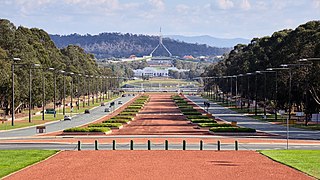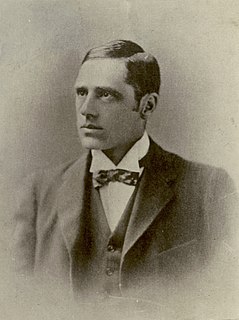
The Australian War Memorial is Australia's national memorial to the members of its armed forces and supporting organisations who have died or participated in wars involving the Commonwealth of Australia, and some conflicts involving personnel from the Australian colonies prior to Federation. The memorial includes an extensive national military museum. The Australian War Memorial was opened in 1941, and is widely regarded as one of the most significant memorials of its type in the world.

Queanbeyan is a city in south-eastern region of the Australian state of New South Wales, located adjacent to the Australian Capital Territory in the Southern Tablelands region. Located on the Queanbeyan River, the city is the council seat of the Queanbeyan-Palerang Regional Council. At the 2016 census, the Queanbeyan part of the Canberra–Queanbeyan built-up area had a population of 36,348.

The Royal Australian Air Force Memorial is on Anzac Parade, the principal ceremonial and memorial avenue of Canberra, the capital city of Australia.
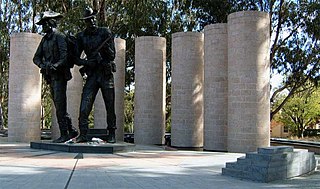
The Australian Army Memorial on Anzac Parade commemorates the service of Australian soldiers.

The Rats of Tobruk Memorial is on Anzac Parade, the principal ceremonial and memorial avenue of Canberra, Australia.
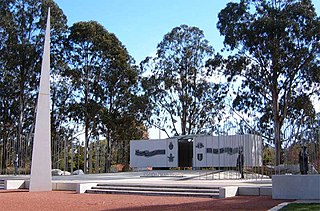
The Australian National Korean War Memorial is on Anzac Parade, the principal ceremonial and memorial avenue in Canberra, the national capital city of Australia.

ANZAC Square is a heritage-listed town square and war memorial located between Ann Street and Adelaide Street, in Brisbane, Queensland, Australia. It is a state memorial to the men and women who participated in overseas armed service and is named in honour of the Australian and New Zealand Army Corps. ANZAC Square is adjacent to ANZAC Square Arcade.
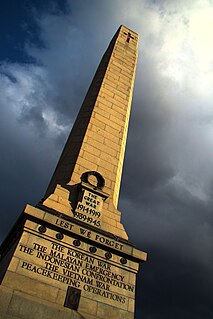
Hobart Cenotaph,, is the main commemorative military monument for the Australian state of Tasmania. It is located in the capital Hobart in a prominent position on the Queens Domain, on a small rise overlooking the city and River Derwent. The Cenotaph sits directly above what was once the location of the Queens Battery.

Central Memorial Park is a park located in central Calgary's Beltline district. Sometimes referred to as Central Park or as Memorial Park, the area is home to the Memorial Park Library, an equestrian statue of Russell Lambert Boyle, and a cenotaph. The former Colonel Belcher Veterans Hospital was located across 4th street SW to the west, now the site of the Sheldon M. Chumir Centre. The Memorial Park Library and the surrounding park were named a National historic site in 2018
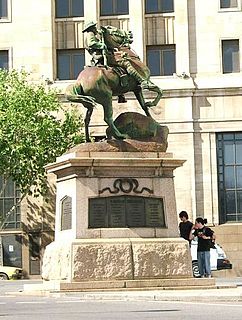
The South African War Memorial is an equestrian memorial dedicated to the South Australians who served in the Second Boer War of 11 October 1899 to 31 May 1902. It was the first war in which South Australians fought, and 1531 men were sent in nine contingents, with over 1500 horses to accompany them. Over 59 South Australians died in the war.

The Horse Memorial is a provincial heritage site in Port Elizabeth in the Eastern Cape province of South Africa, in memory of the horses that served and died during the Second Boer War, where Britain brought a large number of horses to South Africa. Designed by Joseph Whitehead, the life-sized bronze memorial features a kneeling soldier presenting a bucket of water to a service horse.

William Robert Colton RA was a British sculptor. After completing his studies in London and Paris Colton established himself with solid, career-long business relationships, secured admission to exhibitions at the Royal Academy and the Salon in Paris. His works included commissions for busts, statues and war memorials. His clientele included royalty in England and India.

The Boer War Memorial, also known as the South African War Memorial, stands in a prominent position in Queen's Park, Crewe, Cheshire, England. It was erected in memory of local soldiers who had fallen in the Boer War, and consists of a bronze statue of soldier in uniform standing on a column on a stone plinth. The monument was unveiled in 1903, and contains plaques with the names of those who were lost in the war. It is recorded in the National Heritage List for England as a designated Grade II listed building.
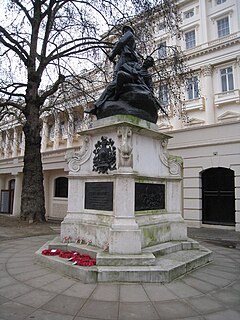
The Royal Marines Memorial, also known as the Graspan Royal Marines Memorial, is an outdoor bronze sculpture by Adrian Jones, installed on the north side of The Mall in London, United Kingdom. Located next to Admiralty Arch, the 1903 memorial commemorates the Royal Marines who died in the Boxer Rebellion in China and the Second Boer War in Africa, and depicts two figures on a Portland stone plinth.

Boer War Memorial is a heritage-listed war memorial at Crescent Street, Gatton, Queensland, Australia. It was designed by William Hodgen and produced by Toowoomba mason William Bruce. It was built in 1908, and was unveiled on 3 August by Governor of Queensland, Lord Chelmsford. The memorial honours four local men who died in or as a result of the war, and is one of only three known Boer War memorials in Queensland. It is also known as the Fallen Soldiers Memorial and the South African War Memorial.
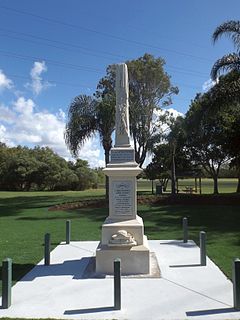
Anning Monument is a heritage-listed memorial at the corner of Hemmant and Tingalpa Road and Boonoo Street, Hemmant, City of Brisbane, Queensland, Australia. It was designed and built by William Busby in 1903. It is also known as Hemmant Boer War Memorial. It was added to the Queensland Heritage Register on 21 October 1992.

The Boer War Memorial is a heritage-listed memorial at Warwick Street, Allora, Southern Downs Region, Queensland, Australia. It was built from 1904 to 1940s. It is also known as Queen's Park and War Memorial Park. It was added to the Queensland Heritage Register on 21 October 1992.

The Anglo-Boer War Memorial was originally called the Rand Regiments Memorial and dedicated to the men of the Witwatersrand who joined as British soldiers in the Rand Regiments and who had lost their lives during the Second Boer War (1899–1902). The memorial is now next door to the South African National Museum of Military History. It was rededicated on 10 October 1999 to all people who died during the Second Boer War and renamed the Anglo-Boer War Memorial.

The King George V Memorial has been located outside Old Parliament House, Canberra since the 1940s. Commissioned in 1936 and largely completed by 1941, it took until 1953 to officially unveil the monument due to delays to the final elements of its construction which resulted from the Second World War. The Memorial was originally located directly in front of the-then Parliament House, but was moved to its current location in 1968.

Streatham War Memorial is a war memorial to the war dead of the London district of Streatham in the two World Wars. It was unveiled in 1922, and is sited near the northwest corner of Streatham Common.




